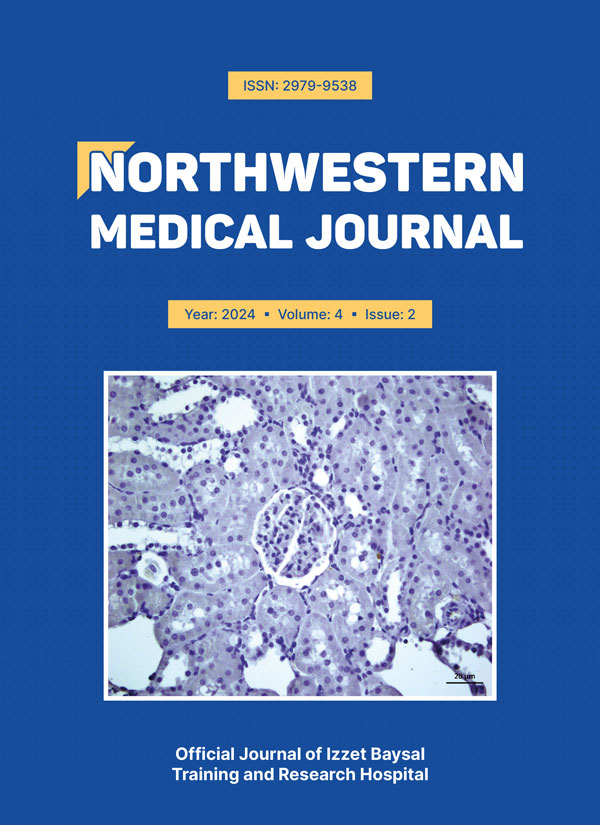Abstract
Aim: In order to prevent any microbiological contamination in laboratories, it is vital to determine both routine microbiological screening and the appropriate protocol. This study was based on this hypothesis and discussed the microbiological contamination and prevention procedures in an anatomy laboratory.
Methods: The study was carried out on 34 different spots in an anatomy laboratory. Swab samples taken from these points were examined for contamination and contamination was detected. The samples were taken from various locations, including the head, upper and lower extremities of both male and female cadavers, the door handle, the floor in front of the door, the faucet, the head, body, and foot parts of the dissection table, the dissection tool, the trailer, the inner and outer coating of the cadaver pool, the sink, the floor in front of the window, the stool, the living room wall, the formaldehyde liquid in the cadaver pool, the window handle, the instrument table, the morgue unit, the exterior surfaces of three different organ storage boxes, the inner surface of an organ storage box, the medical waste container, the handle of the organ storage cabinet, a training model, the lower surface of the dissection table, the medical waste storage box for dissection, and the blackboard.
Results: Bacillus subtilis was found in 16 out of 34 different spots and mold fungus was found in 2 of them. No contamination was detected in the remaining 16 spots. 69% of the spots were directly related to the cadaver.
Conclusion: As a result of our study, the importance of scanning anatomy laboratories in terms of microbiological contamination was highlighted and an appropriate protocol was determined.
Keywords: contamination, anatomy laboratory, microbiological analysis
Copyright and license
Copyright © 2024 The Author(s). This is an open-access article published by Bolu İzzet Baysal Training and Research Hospital under the terms of the Creative Commons Attribution License (CC BY) which permits unrestricted use, distribution, and reproduction in any medium or format, provided the original work is properly cited.
How to cite
References
- Türkseven B, ERBAŞ G. Okul tuvaletlerindeki enterik bakteriyel kontaminasyonun araştırılması. Mersin Üniversitesi Sağlık Bilimleri Dergisi. 2018; 12: 32-40. https://doi.org/10.26559/mersinsbd.437562
- World Health Organization (WHO). WHO Information Series on School Health, Document 10: Creating an Environment for Emotional and Social Well-Being: An Important Responsibility of a Health-Promoting and Child Friendly School. Geneva: WHO; 2003.
- Başustaoğlu AC, Güney M. Klinik Mikrobiyoloji Laboratuvarlarında Biyogüvenlik. Klimud Yayınları. 2012; 2.
- Gümüş HÖ, Etöz OA, Yücesoy T, Kılıç E, Er Ö, Alkan A. Diş hekimliği fakültelerinde kullanılan farklı diş ünitlerinin su ünitlerinin su sistemlerinin geri akım kontaminasyonu açısından değerlendirilmesi. Selcuk Dental Journal. 2014; 1: 55-8. https://doi.org/10.15311/1441.272634
- Alaçam A, Polat S, Özbucak E, Atabek D, Sipahi AB. Diş hekimliğinde öğrenci kliniğinde tedavi öncesi, sırası ve sonrasındaki çevresel kontaminasyon. Gazi Üniversitesi Diş Hekimliği Fakültesi Dergisi. 2008; 25: 1-5.
- Yusuf G, Mustafa İ, Baykalır BG. Araştırma Laboratuvarlarında Biyogüvenlik, Zoonotik Hastalıklar ve Tıbbi Atıkların Bertarafı. Atatürk Üniversitesi Veteriner Bilimleri Dergisi. 2013; 8: 81-96.
- Şeker H, Yardımcı H. Mikrobiyoloji laboratuvarlarında biyogüvenlik. Orlab On-Line Mikrobiyoloji Dergisi. 2003; 1: 3-32.
- Solmaz M, Solmaz T. Tıbbi Laboratuvarlarda Biyogüvenlik. 3rd International Academic Research Congress (ICAR); 2020.
- Kılıç İ, Doğan İ. Veteriner Fakültesi Laboratuvarlarındaki Biyogüvenlik Durumuna Yönelik Akademisyen Görüşleri: Afyon Kocatepe Üniversitesi'nde Bir Uygulama. Kocatepe Veterinary Journal. 2011; 4: 17-23.
- Owolabi JO, Tijani AA, Ihunwo AO. A Need to Protect the Health and Rights of Anatomists Working in Dissection Laboratories. Risk Manag Healthc Policy. 2022; 15: 889-93. https://doi.org/10.2147/RMHP.S362305
- Shoja MM, Benninger B, Agutter P, Loukas M, Tubbs RS. A historical perspective: infection from cadaveric dissection from the 18th to 20th centuries. Clin Anat. 2013; 26(2): 154-60. https://doi.org/10.1002/ca.22169
- Tabaac B, Goldberg G, Alvarez L, Amin M, Shupe-Ricksecker K, Gomez F. Bacteria detected on surfaces of formalin fixed anatomy cadavers. Ital J Anat Embryol. 2013; 118(1): 1-5.
- Koç A, Çetin S, Şener F, Kaçmaz B. Kırıkkale Üniversitesi Tıp Fakültesi'nde sağlık çalışanlarının önlüklerindeki bakteriyolojik kontaminasyonların incelenmesi. Anadolu Güncel Tıp Dergisi. 2020; 2: 1-5. https://doi.org/10.38053/agtd.576836
- Özkeser O. Araştırma ve öğrenci laboratuvarlarında fungal ve bakteriyel mikroorganizmalarının yükünün belirlenmesi [Master’s thesis]. Adana: Çukurova Üniversitesi, Fen Bilimleri Enstitüsü, İş Sağlığı ve Güvenliği Anabilim Dalı; 2019.
- Güldaş N, Alp-Çavuş S, Gülay Z. Yoğun bakım üniteleri ve ameliyathane çalışanlarının cep telefonlarının mikrobiyal kontaminasyonunun araştırılması. Klimik Dergisi. 2018; 31: 227-31. https://doi.org/10.5152/kd.2018.61
- Alpay Y, İrvem A, Yücel M, Yavuz T. Sağlık Çalışanlarının Cep Telefonlarinda Mikroorganizma Kolonizasyonunun Değerlendirilmesi. Balıkesir Sağlık Bilimleri Dergisi. 2015; 4: 148-51.
- Farnsworth CW, Wallace MA, Liu A, Gronowski AM, Burnham CAD, Yarbrough ML. Evaluation of the Risk of Laboratory Microbial Contamination during Routine Testing in Automated Clinical Chemistry and Microbiology Laboratories. Clin Chem. 2020; 66(9): 1190-9. https://doi.org/10.1093/clinchem/hvaa128
- Wang XL, Juan S, Song QQ, et al. Viral contamination source in clinical microbiology laboratory. Biomedical and Environmental Sciences. 2016; 29: 609-11.
- Wurtz N, Papa A, Hukic M, et al. Survey of laboratory-acquired infections around the world in biosafety level 3 and 4 laboratories. Eur J Clin Microbiol Infect Dis. 2016; 35(8): 1247-58. https://doi.org/10.1007/s10096-016-2657-1
- Demiryürek D, Bayramoğlu A, Ustaçelebi S. Infective agents in fixed human cadavers: a brief review and suggested guidelines. Anat Rec. 2002; 269(4): 194-7. https://doi.org/10.1002/ar.10143
- Kaufman MH. Dangerous dissections: the hazard from bodies supplied to Edinburgh anatomists, winter session, 1848-9. J R Coll Physicians Edinb. 2005; 35: 268-74.
- Billette de Villemeur T, Gelot A, Deslys JP, et al. Iatrogenic Creutzfeldt-Jakob disease in three growth hormone recipients: a neuropathological study. Neuropathol Appl Neurobiol. 1994; 20(2): 111-7. https://doi.org/10.1111/j.1365-2990.1994.tb01169.x











